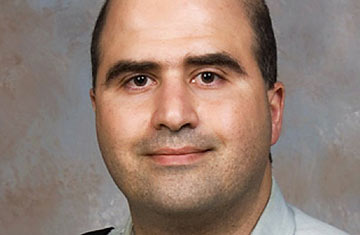
Accused Fort Hood gunman Major Nidal Malik Hasan
Lost amid all the mayhem and tragedy of last week's massacre at Fort Hood is the chilling reality that the alleged killer was a U.S. citizen who may have taken online inspiration from Middle Eastern jihadists without ever leaving the nation's shores. Even more disturbing: This kind of homegrown, lone-wolf terrorism is not only harder to detect; it is likely to grow — as one of the consequences of the U.S.'s war on terrorism. The pounding of al-Qaeda and its allies in Afghanistan, Iraq and Pakistan since 9/11 has driven them onto the defensive, forcing them to spend more time trying to stay one step ahead of the next Predator strike than plotting attacks on targets halfway around the globe. But the collateral damage from U.S. operations in those countries has enraged Muslims around the world, creating an opportunity for jihadists to use the Internet to inspire angry Muslims in the West to action.
"I used to argue it was only terrorism if it were part of some identifiable, organized conspiracy," says Bruce Hoffman, a terrorism expert at Georgetown University and previously at the Rand Corp. and CIA. But he changed his definition in the latest version of his book Inside Terrorism because "this new strategy of al-Qaeda is to empower and motivate individuals to commit acts of violence completely outside any terrorist chain of command." Senator Joe Lieberman of Connecticut has dubbed Fort Hood shooter Major Nidal Malik Hasan a "self-radicalized, homegrown terrorist" — a one-man terrorism cell.
And self-made jihadists with no operational links to organizations or individuals abroad may now be the dominant terrorism threat on U.S. soil. Marc Sageman, a terrorism scholar and onetime CIA case officer in Pakistan, has charted the origins of terrorist events in the West since 2004. "Almost 80% of the plots in the past five years are homegrown groups with no physical links to any transnational terrorists group," he told the Senate Foreign Relations Committee last month. In his 2008 book Leaderless Jihad, Sageman says the "present threat has evolved from a structured group of al-Qaeda masterminds, controlling vast resources and issuing commands, to a multitude of informal local groups trying to emulate their predecessors by conceiving and executing operations from the bottom up."
Sageman told Senators that these self-generated terrorists include a "troubling emerging pattern of lone wolves, directly linked via the Internet to foreign al-Qaeda-affiliated terrorist organizations." Some see evidence of a possible similar link in the case of Hasan, whom the FBI had detected communicating with Yemen-based Anwar al-Awlaki, a firebrand cleric and U.S. citizen who praised the Fort Hood killing spree on his website.
"The nature of terrorism is changing," Hoffman says, "and Major Hasan may be an example of that." There has been a terrorism-related event — either actual or a broken-up plot — every month this year in the U.S., Hoffman adds. "Even if Major Hasan turns out to have had no political motive," he says, "this is a sea change."
Lieberman's Homeland Security Committee warned of the dangers of a homegrown jihadist trend in a report it issued last year. "Radicalization is no longer confined to training camps in Afghanistan or other locations far from our shores; it is also occurring right here in the United States," largely via the Internet, the report said. "The emergence of these self-generated violent Islamist extremists who are radicalized online presents a challenge for law enforcement because lone wolves are less likely to come to the attention of law enforcement." At least, not until they start shooting.
